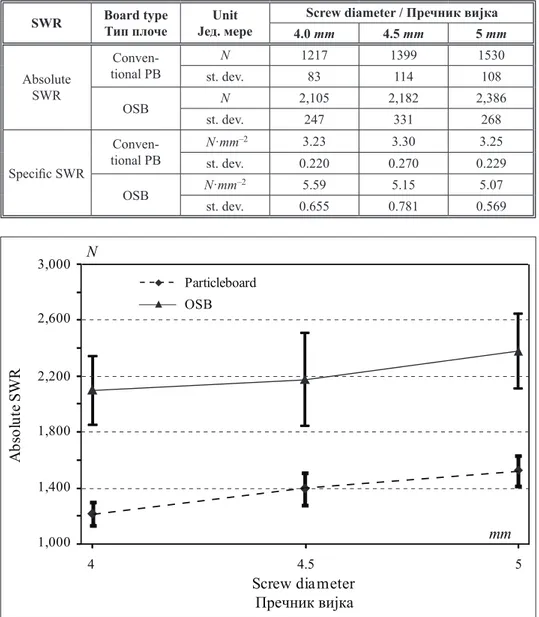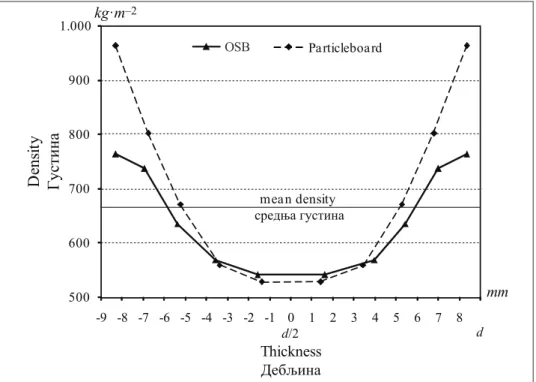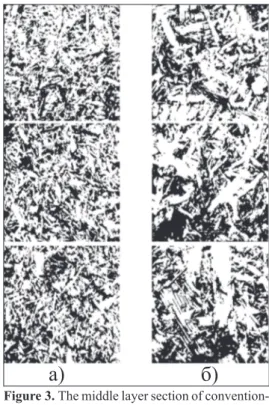Jovan Miljković Mlađan Popović
Milanka Điporović-Momčilović Ivana Gavrilović-Grmuša
EDGE SCREW WITHDRAWAL RESISTANCE
IN CONVENTIONAL PARTICLEBOARD
AND OSB - INFLUENCE OF THE PARTICLES TYPE
Abstract: This research was based on presumption that the changes in size and shape of wood particles are expected to have certain impact on the particleboard quality in general. Since the conventional particleboard (PB) and oriented strand board (OSB) were built of the quite diverse wood particles, they present interesting specimens in the comparison tests. In this work, the inluence of the wood particles type on the edge screw holding performance of conventional particleboard and OSB was inves-tigated. Those tests were obtained with the screw diameters of 4.0 mm, 4.5 mm and
5 mm. Depth of embedment was 30 mm for all tests and with the pilot-hole diameter
kept in the range of 80-90% in respect of the screw root diameter. Additional tests of the thickness density proile and tensile strength perpendicular to the surface of the board were conducted. Since the middle layer structure of the particleboard embeds the screw body, both mentioned parameters are considered important in the aspect of the quality of the edge screw holding performance. In order to have further insight into the conformation of the middle layer, the image survey was obtained on the split board section presenting the surface of the middle layer. Signiicant differences in the SWR performance of OSB and PB was recorded at all screw diameters. For the screw withdrawal tests parameters OSB samples showed 56-73% superior mean values then conventional PB. On the other hand, the OSB showed wider dispersions of measured withdrawal forces at all screw diameters, which might present some of the problems in certain engineering and project calculations.
Key words: conventional particleboard, OSB, screw withdrawal resistance, wood particles
BIBLID: 0353-4537, (2007), 95, p 109-117
UDK: 630*832.2=111 Оригинални научни рад
dr Jovan Miljković, full professor, Belgrade University - Faculty of Forestry, Belgrade mr Mlađan Popović, assistant, Belgrade University - Faculty of Forestry, Belgrade
ОТПОРНОСТ ПРЕМА ИВИЧНОМ ИЗВЛАЧЕЊУ ВИЈКА У КОНВЕНЦИО НАЛНОЈ ИВЕРИЦИ И ОСБ ПЛОЧИ УТИЦАЈ ТИПА ИВЕРЈА Извод: Ово истраживање је засновано на претпоставци да промене у величини и облику иверја могу имати утицај на квалитет плоче иверице уопште. Пошто су конвенционална плоча иверица и плоча иверица од оријентисаног „стренд” иверја (ОСБ) израђене од сасвим различтог иверја, представљају интересантне предмете поређења. У овом раду испитан је утицај типа иверја на ивично др-жање вијака у конвенциопналној и ОСБ плочи иверици. Испитивања су рађена уз употребу вијака пречника 4,0, 4,5 и 5,0 mm. Дубина увртања је износила
30 mm за све тестове, а вијчани отвори су имали пречник у опсегу 80-90% у
од-носу на пречник корена вијка. Такође, обављена су и испитивања дебљинског профила густине и затезне чврстоће управно на површину плоче, пошто оба ова својства представљају показатеље квалитета средњег слоја плоче у коме је смештено тело вијка. У циљу бољег увида у структуру средњег слоја, обављен је визуелни преглед површинског пресека узорка. У раду су утврђене значајне разлике између отпорности према извлачењу вијка код конвенционалне и ОСБ плоче иверице, при свим пречницима вијака. При томе, узорци ОСБ-а показали су 56-73% веће средње вредности силе извлачења у односу на конвенционалну плочу. Са друге стране, ОСБ плоча је показала веће расипање резултата за све пречнике вијка, што може довести до одређених проблема приликом пројек-товања и израде намештаја.
Кључне речи: конвенционала плоча иверица, ОСБ, отпорност према извлачењу вијка, иверје
1. INTRODUCTION
Very recently, Oriented Strand Board (OSB) became widely accepted throughout wood panel consumers in Serbia. Largely, it presents the constructive product, primarily designed to replace plywood panels in building constructions, transportation etc. Some capacities of OSB are designed to it for the interior applications and furniture. Although originating from the same technology, OSB and conventional PB are very diverse in their properties. Firstly, a unique appearance of OSB, with surface hurdled with large strands, is something which is quite obvious. Other and more signiicant differences can be found in the mechanical properties and thus through the end-use performances. This brings us the question of comparison between those two boards, as they belong to the same family of boards with the particle structure, and at the same time with quite different characteristic. This question can be further emphasized knowing that both conventional PB and OSB still overlap in some areas of application.
middle and less compact layer. The screw withdrawal resistance (SWR) in particleboard was researched the most thoroughly at their early industrial era. It is found that SWR is dependent of the board density (Eckelman, 1975). The inluence of the board density on SWR was usually conducted on the laboratory constructed, homo-proile particleboards. Tests concerning the commercial particleboards haven’t yield signiicant relationships of those two parameters (Wong et al., 1999). Another property which might stand important for the edge SWR is the tensile strength perpendicular to the surface of the board. This mechanical property emphasizes the weakest line inside the board structure, often at the central (core) plane, at which the screw body lies (Miljković, Popović, 2004). Litera-ture data on this mater showed certain level of correlation regarding MDF board while not presuming the same for particleboard (Rajak, 1993). The recent tests showed strong cor-relation between tensile strength and the edge SWR for conventional PB, while recording not any level of correlation for OSB (Popović, 2005).
Since the OSB is relatively new product, its screw holding performance was re-searched quite recently, when it was compared with the plywood panel (Erdil, 2002). The results of this testing showed uneven behavior on screw holding performance in OSB. Though the values of withdrawal force were quite superior in comparison with the tests obtained on conventional PB, the dispersion of results was also high. The importance of these tests can be found in results of comparison between various types of connections for wood based panels. Even though the screw connection is very practical, cheap and efi-cient, it presents the most critical constructive solution for any furniture assembly made of particleboard or other composite panels.
The main goal in this work is to compare the SWR performance in both types of tested boards: the conventional PB and OSB. As the wood particles present the main dif-ference between those two types of particleboards, then the additional goal was to inves-tigate the particle composition inside the board. In order to evaluate the inluence of those parameters on SWR the particle size and shape, and its orientation in the middle layer was observed.
2. MATERIALS AND METHODS
The screw pull out tests were conducted on the square test pieces 10×10 cm. Screws were embedded at the middle of each side of the test piece. In the case of conventional PB, a single test group consisted of 6 test pieces allowing a total number of 24 measure-ments. Test group of OSB consisted of 8 test pieces i.e. 32 measuremeasure-ments. For itting the test pieces into the testing tool, the perpendicular hole of the 10 mm in diameter was made at its centre (intersection of diagonals). The pull out tests was obtained on the universal machine for the pressure and pull out testing (Popović, 2005).
As the result of hot pressing process and different particle composition at the given thickness zone, conventional PB and OSB have density gradient throughout their thick-ness. They both could be regarded as the composite boards which consist of several lay-ers, each with its unique properties. Uneaven density distribution along the thickness of the board (density proile) usually resembles the „U” shape with much higher surface density and the lowest density in the midlle layer (Wong et al., 1999). The thickness den-sity proile was examined also using the test pieces of the 10×10 cm size. The method are conceived on successive mechanical removal of thin layers by surface sanding equipment and measurements of the new formed weight using analytical scale. The density of each thickness layer was calculated by the following formula:
LL
L L
L P P
G G $
Ȗ [kg·m–3], where: g(i+1) - density of i+1 layer; m
i and m(i+1) - mass after removal of i and i+1 leyer, di
and d(i+1) - thickness after removal of i and i+1 leyer and A - surface of the test piece. For
the i=0, the values of m
0 and d0 presents the starting mass and thickness of the test piece. The tensile strength was examined on the test pieces of 50×50 mm in size, glued to the metal surface by the hot melted glue and thus inserted into the testing tools. Tests were conducted according the method described in EN 319. For each panel sample 18 test pieces were made.
3. RESULTS AND ANALYSIS
Screw withdrawal resistance (SWR) usually can be expressed as the absolute or speciic value. Speciic SWR takes into calculations the additional factors, namely the longitude of embedment and screw diameter (Albino et al., 1991). Table 1 presents both absolute and speciic values for tested SWR together with their standard deviations.
The results of speciic SWR were tested at the level of signiicance of 5%. OSB showed better results than the conventional PB in all tests. Concerning the screw perfor-mance, separately for each board type, the results showed no signiicant variations. It was expected since the speciic SWR presents the relative value, and the true performance is masked by the connection parameters (embedment length and screw diameter).
clearly showed the superior performance of the OSB. Compared with the conventional PB, the OSB showed the 56% greater values of mean withdrawal force for the screws of 4.5 mm and 5 mm in diameter. Even better performance in favor of OSB was achieved with the screw of 4.0 mm in diameter, which meant by 73% better absolute SWR.
Table 1. Absolute and speciic screw withdrawal resistance - conventional PB and OSB Table 1. Апсолутна и специфична отпорност при вађењу вијка - кон. иверица и ОСБ плоча
SWR Board type
Тип плоче Јед. мереUnit
Screw diameter / Пречник вијка 4.0 mm 4.5 mm 5 mm
Absolute SWR
Conven-tional PB
N 1217 1399 1530
st. dev. 83 114 108
OSB N 2,105 2,182 2,386
st. dev. 247 331 268
Speciic SWR
Conven-tional PB
N·mm–2 3.23 3.30 3.25
st. dev. 0.220 0.270 0.229
OSB N·mm–2 5.59 5.15 5.07
st. dev. 0.655 0.781 0.569
Figure 1. The inluence of the screw diameter on the withdrawal force for conventional PB & OSB Слика 1. Утицај пречника вијка на силу извлачења код конвенционалне иверице и ОСБ плоче
$
EV
RO
XW
H6
:
5
6FUHZGLDPHWHU ɉɪɟɱɧɢɤɜɢʁɤɚ 3DUWLFOHERDUG
26%
The igure 1 shows the inluence of the screw diameter on the screw withdrawal force (absolute SWR). The curves on the diagram presents each board type performance at the given screw diameter. The increase in the mean values of withdrawal force can be noticed with the increase in screw diameter. On the same igure, as well as on the table 1, it can be noticed that the OSB, having better withdrawal force values, also posses quite increased dispersion in measurements, which responds on the signiicantly grater standard deviations.
The mean density of the conventional PB was 681.3 kg·m–3 and was signiicantly grater than the density of the OSB (613.1 kg·m–3). The density gradient also resulted in quite different curves regarding the board type (igure 2). It was expected since the produc-tion factors are distinctive for the given board. The convenproduc-tional PB has highly compact and high density surface structure composed of the ine particles in regards of its coarse and light-weight middle layer. OSB posses much uniformly density gradient throughout its thickness, presumably thanks to much bigger strand particles on its surface which in the certain levels confronts to the press effects. Thus, quite different density gradients have the area of compliance at the middle zone of the board. And what is important for the edge screw withdrawal tests, the middle layer density between both types of the particleboards showed no signiicant difference.
Figure 2. Thickness density proile of conventional PB and OSB
Слика 2. Дебљински профил густине за конвеционалну иверицу и ОСБ плочу
'
HQV
LW\
Ƚɭɫɬɢɧɚ
7KLFNQHVV Ⱦɟɛʂɢɧɚ
26% 3DUWLFOHERDUG
G G
PHDQGHQVLW\ ɫɪɟɞʃɚɝɭɫɬɢɧɚ
The tensile strength perpendicu-lar to the surface was better in the OSB (0.53 N·mm–2) then in conventional PB (0.41 N·mm–2), with standard deviations of 0.061 and 0.043, respectively. It gen-erally corresponds with the results of the SWR testing, and again indicating the su-perior mechanical properties of OSB.
On the igure 3, the composition of the middle layer of conventional PB (igure 3a) and OSB (igure 3b) can be observed. It can be noticed that the mid-dle layer of OSB consists of the larger wood particles, than the conventional PB. Strands of the OSB posses much larger contact surface, which affects in the bet-ter adhesion and the more compact struc-ture of the board in general, thus resulting in better mechanical properties.
But contrary to conventional PB, the surface of the OSB panels consists ex-clusively of larger strands, while the mid-dle layer are characterized by the wider range of strands fractions and even in-cluding the smaller particles. Such con-formation of the OSB results in creating uneven areas in the middle layer struc-ture. On the igure 3, the clusters of large
strands can be noticed, surrounded with the areas illed with smaller particles. While em-bedding into the edge of the OSB, the screw thread often contacts both large strands and the pockets of smaller particles. In regard of the given structure conformation in which the screw shank might be more or less embedded, the SWR performance could be affected. This could explain the high distribution of the SWR results for OSB. Further image survey and the statistical image analysis could reveal iner relations inside the structure of vari-ous particleboard types.
4. CONCLUSIONS
The screw withdrawal tests showed signiicantly better edge screw holding perfor-mance for OSB. The mean values of absolute SWR was 56-73% greater in OSB comparing to conventional PB for all test parameters, i.e. screw diameters.
Figure 3. The middle layer section of convention-al PB (a) and OSB (б) - Notice: each
im-age presents the test piece of 10×10 cm Слика 3. Површински пресек конвенционалне
иверице (а) и ОСБ плоче (б) - Напо мена: свака слика представља испитну еп рувету формата 10×10 cm
The maximum absolute SWR was achieved at OSB samples and with the screw of 5 mm in diameter.
The density proile tests showed different density distributions regarding both types of particleboards. But when the central thickness zone was isolated, it showed no signii-cant difference in densities of the middle layer of both conventional PB and OSB. There-fore, the density of the middle layer of the bord was excluded as non-affecting factor for SWR in this work.
The OSB yiled by 29% better tensile strangth than the conventional PB and again showed its better mechanical properties and the superior middle layer structure, as it was the case with SWR.
It is possible that the size and shape of wood particles, and its conformation in the middle layer, have signiicant inluence both on tensile strength and on edge SWR.
REFERENCES
Albin R., Dusil F., Feigl R., Froelich H.H., Funke H. (1991): Grundlagen des Modebel- und Innenausbaus, DRW - Verlag
Wong E.D., Zhang M., Wang Q., Kawai S. (1999): Formation of the density proile and its ef-fects on the properties of particleboard, Wood Science and Technology 33, Springer-Verlag (327-340)
Ђипоровић М.М., Поповић М., Миљковић Ј., Грмуша Г.И. (2006): Ивично држање вијака у конвенционалној плочи иверици, Прерада дрвета 29-34, Шумарски факултет Универзитет у Београду, Београд (15-16)
Eckelman C.A. (1975): Screwholding Performance in Hardwoods and Particleboard, Forest Products Journal, Madison, Vol. 25(6) (30-35)
Erdil Y.Z., Zhang J., Eckelman C.A. (2002): Holding strenght of screws in plywood and ori-ented strandboard, Forest Products Journal, Madison, Vol. 56(6) (55-62)
Миљковић Ј., Поповић М. (2004): Испитивање отпорности на ивично извлачење вијака за дрво са упуштеном главом из савремене плоче иверице, Прерада дрвета 15-19 (6), Шумарски факултет Универзитет у Београду, Београд
Поповић М. (2005): Утицај неких физичких и механичких својстава ОСБ и конвенционалне плоче иверице на ивично држање вијка, магистарски рад у рукопису, Шумарски факултет Универзитет у Београду, Београд
Јован Миљковић Млађан Поповић
Миланка Ђипоровић-Момчиловић Ивана Гавриловић-Грмуша
ОТПОРНОСТ ПРЕМА ИВИЧНОМ ИЗВЛАЧЕЊУ ВИЈКА У
КОНВЕНЦИОНАЛНОЈ ИВЕРИЦИ И ОСБ ПЛОЧИ УТИЦАЈ ТИПА ИВЕРЈА
Резиме


